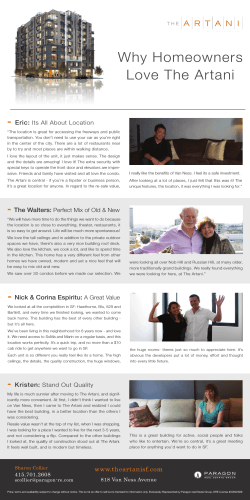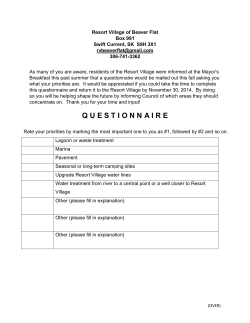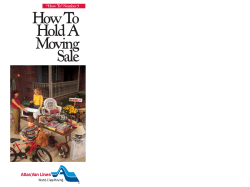
Europe Campervan, by E
WORDS AND PICS GARY AND LINDA HILL Europeby Campervan, Not Just For The Young Travelling through Europe isn’t reserved for the youthful or the wealthy. E xploring Britain and Europe by campervan is something young Australians have been doing for years. Linda and I had long wanted to do the same but although fairly adventurous, being in our mid-50s we had become used to reasonable comfort and reliability in our travel. We decided to take six months for the tour and, after some research, decided that buying a campervan and selling it at the end of the trip was the cheapest option, but buying privately or checking out the street market in the London suburb of Islington where young travellers trade every weekend was too time-consuming. 88 MAY/JUNE 2006 RVPoint.com.au A number of companies offer vans with a buy-back option of up to 80 per cent of the price but we found that Campervans4U.com, run by Andy and Lisa Brady who specialise in VW Campervans imported from Germany, had a particularly informative website and were happy to provide a list of previous customers for us to contact. The Westfalia-built VWs enjoy a good reputation for quality and are well laid out. Andy suggested we give him a list of what we wanted and he would send us photos of anything suitable before he advertised it. With three weeks to go he found just what we needed in Frankfurt, a 1991 VW T4 Westfalia High top, powered by a 2.4L diesel motor, but our $20,000 budget had to be stretched to $25,000 to get the features we wanted. On a previous trip to England we had set up a UK bank account, something that travel agents and Australian banks can now arrange, which made sending a cheque easy. We also made sure we had Internet banking on this and our Australian account. Campervans4U is located in a small village near Stansted airport in Essex. Our van was standing outside a beautiful 16th century thatched house that had been both the local garage and a pub. After a thorough check and instructions on how everything worked we used the office computer to transfer the final payment. Insurance was arranged on the phone with Downunder Insurance, a London company run by an Australian. Most UK insurers require you to have a British licence and without that the price is quite high. We took the 12-month cover for £600 ($1500) as we were considering keeping the van for a return trip if all went well, but had the option of a rebate if we cancelled after six months. We joined the Camping and Caravanning Club, which provided reduced fees for members and even more savings for being over 55, so there are benefits to getting older. The club sites we stayed at were all really good, with great locations and well maintained grounds and facilities. May in England was brilliant: the weather was pleasant which allowed us to enjoy the great network of country roads and public footpaths that are so easily accessible. It was a still a bit cold at night, making us glad our van had a built-in Eberspacher heater which runs on diesel from the van’s fuel tank. We left plenty of time to get to Folkestone to board the Eurotunnel train for France. We could have saved money by using a ferry but it’s not every day you get to travel under the sea. Booking in advance and travelling at odd times gives the best fares. The journey to Calais takes 35 minutes plus at least another 30 minutes for security checks and loading, while at the other end you simply drive off, straight into Eurocity, a huge shopping centre, which is popular with British day trippers stocking up on cheap alcohol and cigarettes. It’s a great place to get your first experience of a European supermarket and sample some of the wonderful food. Although not essential, it is good to learn a little of the local languages. If you attempt to speak the language you will often get a response in English, but it is fun to try, and an Instant Italian or Get by in French CD beats I Spy on the journey. We intended to spend most of our time in Italy, combining the obvious tourist spots with getting off the beaten track and seeing life in the small villages. The first stop was the wonderfully preserved mediaeval town of Brugge (Bruges). Here we discovered the delights of Belgian beer and chocolate, and also resolved to get a rack and bikes after finding Opposite top: Mediaeval village of Scanno. Oppposite centre: Villeta Barrea, Abruzzo National Park, Italy. Opposite below: Free motorhome park near Cortina, Italy. Above right: Heading for France on the Eurotunnel train. Above left: Camping by the Moselle River, Trittenheim, Germany. Right: Which way now? Tuscany, Italy. RVPoint.com.au MAY/JUNE 2006 89 Right: Campsite at Neunbrunnen Forest lake, Maishofen, Austria. Below: Crossing the Grossglockner Pass through Austria’s highest mountains. European Fast Facts CAMPERVAN: 1991 VW T4 2.4L diesel, left-hand drive, 5 speed manual, which averaged 9L/100km CONTACTS: VW campervans: Campervans4U.com Insurance: duinsure.com UK campsites: campingandcaravaningclub. co.uk Europe and UK campsites: acsi-gids.com; eurocampings. net; campingcar-magazine.fr Channel crossing: eurotunnel. co.uk; intoferries.co.uk Bike rack can be supplied by Campervans4U Storage boxes and tools: B&Q (similar to Bunnings) in most large towns ESSENTIALS TO TAKE WITH YOU FROM AUSTRALIA: Try to take things that you don’t have to bring home again Old doona and sheets, they don’t have to fit perfectly in the van, and old towels Large scale touring maps of Europe, often on sale in Australian newsagents Travel guides, phrase books and reading books Language CDs Small Camping Gaz stove is cheaper here and gas is readily available. Saves smelly cooking in van Camera with plenty of film or memory Laptop computer very useful Electric plug adapter, UK and Europe are 240V. The van will have European sockets 90 MAY/JUNE 2006 RVPoint.com.au how bicycle-friendly Europe is. A fellow traveller recommended the ACSI guide, which we found in a local camping shop. It is printed in Dutch but comes with a CD Rom in all languages. Using the laptop we were able to search over 8000 campsites and get a route map and directions to campsites all over Europe. This was one of the best buys we made, especially as it came with a discount card which halved the cost of nightly stay to only €13 ($22) at many sites. On one excursion we found a small overnight camping ground on the banks of the Moselle River in the winemaking town of Trittenheim in Germany. At only €7 ($12) per night this was one of a network of cheap or free camping areas provided especially for campervans. An English couple gave us an old copy of Aires de Services published by the French Camping Car Magazine, which lists many of these. We also learned to look out for the sign showing a diagram of a campervan, which usually meant a free stop. We fell in love with Austria, where we felt we were driving through a postcard, with incredible views around every corner. While camped by a lake near Maishofen we had a problem with our 240V main switch but soon had it repaired by a local electrician, and Campervans4U reimbursed us when we sent the receipt. We then headed for Italy via the Grossglockner Pass, an absolutely “must do” drive, which winds through the highest mountains in Austria. We used an Autostrade (Freeway), a quick but expensive tolled route to Venice, and thence into the hills of Tuscany. We saw an advert for a festival in the village of Vicchio, which had a discount campsite just 10 minutes’ walk from the village square. Along with the free entertainment, for a very reasonable price we could enjoy local food and wine served a tavola. This means “at the table” and is used to raise money for local charities, a bit like a Lions Club sausage sizzle, but with three courses and wine, in a 1000-year-old village square. Although on a budget we did eat out occasionally, finding the best food away from the tourist areas, but for the most part we cooked ourselves. In six months we barely scratched the surface of Europe, but this was not about seeing as much as possible but about maximising the enjoyment, and we have kept the van so we can do it again. ■
© Copyright 2025





















